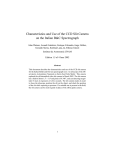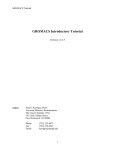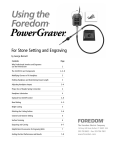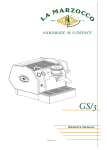Download Two-mode networks - Affiliations, bibliographic
Transcript
Unit 7: Affiliations Data and Bibliographic Research ICPSR University of Michigan, Ann Arbor Summer 2015 Instructor: Ann McCranie "Affiliations" Relational in three ways (Wasserman and Faust, pg 295) 1.Show how actors and events are related to one another 2.Events create ties among actors 3.Actors create ties among events Note: You are no longer considering pairs of actors, but instead are considering subsets of actors. Classic Study: Southern Ladies Davis, Gardner, Gardner 1941. Deep South: a Social Anthropological Study of Caste and Class See also: Freeman, Linton. 2003 Finding Social Groups: A Meta-Analysis of the Southern Women Data) 1 EVELYN 2 LAURA 3 THERESA 4 BRENDA 5 CHARLOTTE 6 FRANCES 7 ELEANOR 8 PEARL 9 RUTH 10 VERNE 11 MYRNA 12 KATHERINE 13 SYLVIA 14 NORA 15 HELEN 16 DOROTHY 17 OLIVIA 18 FLORA 1 E 1 1 0 1 0 0 0 0 0 0 0 0 0 0 0 0 0 0 2 E 1 1 1 0 0 0 0 0 0 0 0 0 0 0 0 0 0 0 3 E 1 1 1 1 1 1 0 0 0 0 0 0 0 0 0 0 0 0 4 E 1 0 1 1 1 0 0 0 0 0 0 0 0 0 0 0 0 0 5 E 1 1 1 1 1 1 1 0 1 0 0 0 0 0 0 0 0 0 6 E 1 1 1 1 0 1 1 1 0 0 0 0 0 1 0 0 0 0 7 E 0 1 1 1 1 0 1 0 1 1 0 0 1 1 1 0 0 0 8 E 1 1 1 1 0 1 1 1 1 1 1 1 1 0 1 1 0 0 1 9 E 1 0 1 0 0 0 0 1 1 1 1 1 1 1 0 1 1 1 1 0 E 0 0 0 0 0 0 0 0 0 0 1 1 1 1 1 0 0 0 1 1 E 0 0 0 0 0 0 0 0 0 0 0 0 0 1 1 0 1 1 1 2 E 0 0 0 0 0 0 0 0 0 1 1 1 1 1 1 0 0 0 1 3 E 0 0 0 0 0 0 0 0 0 0 0 1 1 1 0 0 0 0 4 E 0 0 0 0 0 0 0 0 0 0 0 1 1 1 0 0 0 0 Two-Mode Data Issues Think carefully about the assumptions behind the collection of actors and events. Does belonging to the same organization count as an affiliation? What about belonging to the same type of organization? How about sharing the same attitude? Also, deciding on the population boundaries of each is important. Duality of Actors and Events Two-Mode Centrality: Bipartite Matrix 1 EVELYN 2 LAURA 3 THERESA 4 BRENDA 5 CHARLOTTE 6 FRANCES 7 ELEANOR 8 PEARL 9 RUTH 10 VERNE 11 MYRNA 12 KATHERINE 13 SYLVIA 14 NORA 15 HELEN 16 DOROTHY 17 OLIVIA 18 FLORA 19 E1 20 E2 21 E3 22 E4 23 E5 24 E6 25 E7 26 E8 27 E9 28 E1 29 E11 30 E12 31 E13 32 E14 1 1 2 3 4 5 6 7 8 9 0 E L T B C F E P R V - - - - - - - - - - 1 1 M - 1 2 K - 1 3 S - 1 4 N - 1 5 H - 1 6 D - 1 7 O - 1 8 F - 1 9 E 1 1 1 2 0 E 1 1 1 2 1 E 1 1 1 1 1 1 2 2 E 1 2 3 E 1 1 1 1 1 1 1 1 1 1 1 2 4 E 1 1 1 1 1 1 1 1 1 1 1 1 1 1 1 1 1 1 1 1 1 1 1 1 1 1 1 1 1 1 1 1 1 1 1 1 1 1 1 1 1 1 1 1 1 1 1 1 1 1 1 1 1 1 1 1 1 1 1 1 1 1 1 1 1 1 1 1 1 1 1 1 1 1 1 1 1 1 1 1 1 1 1 1 1 1 1 1 1 1 1 1 1 1 1 1 1 2 5 E - 2 6 E 1 1 1 1 1 1 1 1 1 1 1 1 1 1 1 1 1 1 1 1 1 1 1 1 2 7 E 1 2 8 E - 2 9 E - 3 0 E - 3 1 E - 3 2 E - 1 1 1 1 1 1 1 1 1 1 1 1 1 1 1 1 1 1 1 1 1 1 1 1 1 1 1 1 1 1 1 1 Two-Mode Data: Basic Measures Properties you should know: Rates of participation (W&F 312-313) a size of events (W & F313-314) UCINET now has some nice measures you can easily compute: 2-Mode Cohesion Measures for davis dataset. Matrix 1 1 2 3 4 5 6 7 Density Avg Dist Radius Diameter Fragmenta Transitiv Norm Dist --------- --------- --------- --------- --------- --------- --------0.353 2.306 3.000 4.000 0.000 0.619 0.647 NOTE: If fragmentation is > 0, the graph is disconnected. All measures based on lengths of geodesics are computed within components. Density is the number of ties divided by n*m, where these no. of rows and cols in matrix. Avg Dist is the average geodesic path length in the bipartite graph, within components. Radius is the smallest eccentricity in the bipartite graph, within components. Diameter is the length of the longest geodesic in the bipartite graph, within components. Transitivity is the no. of quadruples with 4 legs divided by no. with 3 or more legs, in bipartite graph. Norm Dist is Avg Dist divided into minimum possible in bipartite graph of given node-set sizes. Two-Mode Data: Network Density For the “actors,” density is the average number of events attended by all pairs of actors. You can do something similar for event density. Two-Mode Data: Network Centrality Actor Degree Centrality in an affiliation network is the total number of actors contacts that the actor (i) has through its attendance at all events. Sum that actor's row in the coattendence matrix. (You can also do something similar for events.) Centrality for Davis 2-Mode Centrality Measures for ROWS of davis 1 EVELYN 2 LAURA 3 THERESA 4 BRENDA 5 CHARLOTTE 6 FRANCES 7 ELEANOR 8 PEARL 9 RUTH 10 VERNE 11 MYRNA 12 KATHERINE 13 SYLVIA 14 NORA 15 HELEN 16 DOROTHY 17 OLIVIA 18 FLORA 1 2 3 4 Degree Closeness Betweenne Eigenvect --------- --------- --------- --------0.571 0.800 0.097 0.335 0.500 0.727 0.051 0.309 0.571 0.800 0.088 0.371 0.500 0.727 0.049 0.313 0.286 0.600 0.011 0.168 0.286 0.667 0.011 0.209 0.286 0.667 0.009 0.228 0.214 0.667 0.007 0.180 0.286 0.706 0.017 0.236 0.286 0.706 0.016 0.218 0.286 0.686 0.016 0.187 0.429 0.727 0.047 0.220 0.500 0.774 0.072 0.277 0.571 0.800 0.113 0.264 0.357 0.727 0.042 0.201 0.143 0.649 0.002 0.131 0.143 0.585 0.005 0.070 0.143 0.585 0.005 0.070 2-Mode Centrality Measures for COLUMNS of davis 1 2 3 4 Degree Closeness Betweenne Eigenvect --------- --------- --------- --------0.167 0.524 0.002 0.142 0.167 0.524 0.002 0.150 0.333 0.564 0.018 0.253 0.222 0.537 0.008 0.176 0.444 0.595 0.038 0.322 0.444 0.688 0.065 0.328 0.556 0.733 0.130 0.384 1 2 3 4 5 6 7 E1 E2 E3 E4 E5 E6 E7 8 9 E8 E9 0.778 0.667 0.846 0.786 0.244 0.226 0.507 0.379 10 E10 11 E11 0.278 0.222 0.550 0.537 0.011 0.020 0.170 0.090 12 E12 13 E13 14 E14 0.333 0.167 0.167 0.564 0.524 0.524 0.018 0.002 0.002 0.203 0.113 0.113 These are routines available in UCINET under “Network->2Mode Networks and provide appropriate normalizations for the values. (If you just forced your data into a bipartite graph it would not be normalized correctly for the number of actors and events.) Closeness and Betweeness We can also get closeness and betweenness measures for two-mode networks, but we have to change the way they are normalized in order to reflect the fact that we have nodes that, by definition, can not be adjacent to one another. Read Extending Centrality by Everett and Borgatti in Carrington for more, but think of this. Actor i closeness centrality: h + 2g - 2 Cc(i) Correspondence Analysis (See Faust, Chapter 7 in Carrington, for excellent description) Correspondence Analysis looks at the correlations between two sets of variables and is used to locate actors and events simultaneously: actors near events they attended and events near actors who attended them. Correspondence analysis uses singular value decomposition of a normalized version of your g x h matrix Factions in 2-mode data Starting fitness: 0.000 Final fitness: 0.490 Correlation to ideal: 0.490 Blocked Adjacency Matrix 1 EVELYN 2 LAURA 3 THERESA 4 BRENDA 5 CHARLOTTE 6 FRANCES 7 ELEANOR 8 PEARL 9 RUTH 10 VERNE 11 MYRNA 12 KATHERINE 13 SYLVIA 14 NORA 15 HELEN 16 DOROTHY 17 OLIVIA 18 FLORA 1 2 3 4 5 6 7 8 9 10 11 12 13 14 E1 E2 E3 E4 E5 E6 E7 E8 E9 E10 E11 E12 E13 E14 --------------------------------------------------------------------------------------| 1.000 1.000 1.000 1.000 1.000 1.000 1.000 | 1.000 | | 1.000 1.000 1.000 1.000 1.000 1.000 1.000 | | | 1.000 1.000 1.000 1.000 1.000 1.000 1.000 | 1.000 | | 1.000 1.000 1.000 1.000 1.000 1.000 1.000 | | | 1.000 1.000 1.000 1.000 | | | 1.000 1.000 1.000 1.000 | | | 1.000 1.000 1.000 1.000 | | | 1.000 1.000 | 1.000 | | 1.000 1.000 1.000 | 1.000 | ----------------------------------------------------------------------------------------| 1.000 1.000 | 1.000 1.000 | | 1.000 | 1.000 1.000 1.000 | | 1.000 | 1.000 1.000 1.000 1.000 1.000 | | 1.000 1.000 | 1.000 1.000 1.000 1.000 1.000 | | 1.000 1.000 | 1.000 1.000 1.000 1.000 1.000 1.000 | | 1.000 1.000 | 1.000 1.000 1.000 | | 1.000 | 1.000 | | | 1.000 1.000 | | | 1.000 1.000 | ---------------------------------------------------------------------------------------- Density matrix 1 1 2 2 ----- ----0.625 0.074 0.153 0.537 Turning Two-Mode into One-Mode Symmetric Valued Data Most common way to convert is called "crossproducts." This method takes each entry of the row for actor A, and multiplies it times the same entry for actor B, and then sums the result. • For binary data this ends up with a measure of concurrent attendance/membership. • For valued data, you can use a "minimums" method: taking the smallest value of a pair of actor's ties to events and summing that with all other actors. Other places to go… • Knoke and Yang: Social Network Analysis (2008) • Faust: Using Correspondence Analysis for Joint Displays of Affiliation Networks (in Carrington, Scott and Wasserman) • Roberts, J. M. Correspondence analysis of two-mode network data. Social Networks, 22:65-72, 2000. • "Finding Social Groups: A Meta-analysis of the Southern Women Data" In Ronald Breiger, Kathleen Carley and Philippa Pattison (eds.) Dynamic Social Network Modeling and Analysis. Washington, D.C.:The National Academies Press, 2003. • Borgatti, S. P. and M. G. Everett. Network analysis of 2mode data. Social Networks, 19(3):243-269, 1997. Recent extensions to 2-mode data • Blockmodeling • P Doreian, V Batagelj..., Generalized blockmodeling of two-mode network data Social Networks, 200 • Large two-mode networks • Matthieu Latapy, Clemence Magnien, Nathalie Del Vecchio, Basic notions for the analysis of large two-mode networks, Social Networks, Volume 30, Issue 1, January 2008, Pages 31-48 • ERGM/p* models • P. Wang, K. Sharpe, G. Robins and P. Pattison, Exponential random graph models for affiliation networks, Social Networks 31 (1) (2009), pp. 12–25 A demonstration and reminder • Sci2 • There data available for you to download on the course webpage. AN INTRODUCTION TO BIBLIOGRAPHIC NETWORK ANALYSIS Scientometrics is an independent and diverse field • Literally, measuring and analyzing science (all kinds). • Today we’re just in a tiny little corner of “bibliometric” analysis • Co-authorship • Citation • But this field covers all sorts of ways of quantifying and evaluating scientific efforts. Bibliographic Network Analysis • Is often focused on citation or authorship patterns that can be found within fields • Co-authorship is pretty clear – shared authorship of an article • Citation analysis can be thought of differently. Two common ways: • “bibliometric coupling, where two citing articles are similar to the extent they cite the same literature, and co-citation analysis where cited articles are similar to the extent they are cited by the same citing articles” Hummon and Doriean Social Networks Volume 11, Issue 1, March 1989, Pages 39-63 • Citation networks are an interesting case, because at their most basic they are directed, acyclic data. (A paper cites a paper that was written earlier, that older paper can never cite anything published later.) Bibliographic network analysis • Can detect subcommunities in research fields • Can (and has been) be used to “map science” • Can be used to identify prominent actors in a research field • Can be used to identify conflict and consensus in science • Can be used to trace the development of ideas Why might you want to do this if you aren’t into bibliometrics? • Get a handle on an intellectual field • The people in that field • The academic work they produce and what is most cited • The clusters and divisions of the people and ideas in the field • Maybe you just want to find the biggest stars and greatest hits – there are now a lot of tools to help you do that. Studying Bibliographic Networks • These are special types of social networks • Instead of two scholars being linked together by their relationship (such as being friends or naming each other as colleagues), two scholars are linked in a bibliographic network by the work they produce together. • In a citation network, two papers are linked by the works they both cite or the works that both cite them. • These are a type of “affiliation” network, technically a type of “two-mode” network. Two Mode Network Actors & Events Two Mode turned into One Mode Network (Just Actors) SCI2 TOOL DEMONSTRATION Download the tool and documentation: https://sci2.cns.iu.edu/ A science of science tool Types and level of Analysis Why (or why not) to use Sci2 Pros • • • • • • Friendly interface Strong, extensive documentation with sample workflows Powerful parsing capabilities for both general and specific file types Works well in using and producing common data products so movement between programs is not difficult (R, Pajek, visone, Gephi) Can handle very large datasets Can be customized with plug-ins Cons • Fewer (ready) implemented algorithms than statnet, UCINET, or Pajek • Less flexible visualization within the program • Adding plug-ins can be daunting. For more information about other software that could be of interest for the study of science, see section 8.2 of the Sci2 user manual for listing and discussion. Data suited for this tool Specific file formats • • Publications • • • • • • • Refer/BibIX/enw BibTeX ISI Web of Science Scopus Google Scholar Google Citation • • • • • • • • • • Funding • • • Network Formats NSF Award Search NIH RePORTER Scholarly Database • Other Formats • • • • • • GraphML (*.xml or *.graphml) XGMML (*.xml) Pajek .NET (*.net) NWB (*.nwb) Scientometric Formats ISI (*.isi) Bibtex (*.bib) Endnote Export Format (*.enw) Scopus csv (*.scopus) NSF csv (*.nsf) Pajek Matrix (*.mat) TreeML (*.xml) Edgelist (*.edge) CSV (*.csv) Databases Scholarly Database: http://sdb.cns.iu.edu/search/ Free Online Course: http://ivmooc.appspot.com/course Micro: Individual Scientist From Sci2 User Manual: Figure 5.1: Co-authorship network of Katy Börner GUESS supports the repositioning of selected nodes. Multiple nodes can be selected by holding down the 'Shift' key and dragging a box around specific nodes. The final network can be saved via 'GUESS: File > Export Image' and opened in a graphic design program to add a title and legend. The image above was created using Adobe Photoshop. Node clusters were highlighted and increased in size, the label font size was increased for emphasis, and a legend was added to clarify the significance of node and edge size and color. http://sci2.wiki.cns.iu.edu/display/SCI2TUTORIAL/5.1+Individual+Level+Studies++Micro Micro: Trends for Individual Scientist From Sci2 User Manual: Figure 5.3: Horizontal Bar Graph of KatyBorner.nsf http://sci2.wiki.cns.iu.edu/display/SCI2TUTORIAL/5.1+Individual+Level+Studies+-+Micro Micro: Trends for Individual Scientist From Sci2 User Manual: http://sci2.wiki.cns.iu.edu/display/SCI2TUTORIAL/5.2+Institution+Level+Studies++Meso Micro: Four Scientists Meso: A Research Field From: McCranie 2013, unpublished dissertation in progress. Image in middle above is largest single component of the paper-citation network of “recovery” research literature from 1991-2012 . Top right image is Pathfinder Network Scaling of the most cited works in transformed co-citation network color coded by content analysis of articles. Bottom right is co-authorship network coded by disciplinary field. Data prep and analysis in Sci2, visualization in visone with added legends and graphic elements in Inkscape. 36 Simple, but important! The Demonstration • Basic Features of Sci2 • Citation and co-authorship networks (with special emphasis on preparing and cleaning data) • Topical analysis and visualization • Available data and ways to pull it into Sci2 • Questions & discussion THE BASIC FUNCTIONALITY The Basics • Opening Data • Data Preparation • Preprocessing • Analysis • Modeling • Visualization Visualizing the Florentine dataset • Data Acquisition & Preprocessing • Examine the data • Load the data into NWB • Data Analysis, Modeling, & Layout • Since the data is formatted as a network with various attributes added to the nodes and edges – only simple analysis will be conducted on this network. • Data communication & Visualization Layers • Visualize the Florentine network with GUESS Visualizing the Florentine dataset • Florentine families related through business ties (specifically, recorded financial ties such as loans, credits and joint partnerships) and marriage alliances. • Node attributes • • • Wealth: Each family's net wealth in 1427 (in thousands of lira). Priorates: The number of seats on the civic council held between 1282-1344. Totalities: Number of business/marriage ties in complete dataset of 116 families. • Edge attributes: Marriage T/F & Business T/F • “Substantively, the data include families who were locked in a struggle for political control of the city of Florence around 1430. Two factions were dominant in this struggle: one revolved around the infamous Medicis, the other around the powerful Strozzis.” More info is at http://svitsrv25.epfl.ch/R-doc/library/ergm/html/florentine.html and Padgett & Ansell 1993 ( http://home.uchicago.edu/~jpadgett/papers/published/robust.pdf) • Visualizing the Florentine dataset FILE> LOAD the Florentine dataset: sampledata/ socialscience/ florentine.nwb To view the file, right click on the network in the data manager and select view as. Select a text editor. Visualizing the Florentine dataset *Nodes id*int label*string wealth*int totalities*int priorates*int 1 "Acciaiuoli" 10 2 53 2 "Albizzi" 36 3 65 3 "Barbadori" 55 14 0 4 "Bischeri" 44 9 12 5 "Castellani" 20 18 22 6 "Ginori" 32 9 0 7 "Guadagni" 8 14 21 8 "Lamberteschi" 42 14 0 9 "Medici" 103 54 53 10 "Pazzi" 48 7 0 11 "Peruzzi" 49 32 42 12 "Pucci" 3 1 0 13 "Ridolfi" 27 4 38 14 "Salviati" 10 5 35 15 "Strozzi" 146 29 74 16 "Tornabuoni" 48 7 0 *UndirectedEdges source*int target*int marriage*string business*string 9 1 "T" "F" 6 2 "T" "F" 7 2 "T" "F" 9 2 "T" "F" 5 3 "T" "T" Visualizing the Florentine dataset To visualize the Florentine network select Visualization > GUESS and NWB will launch GUESS. To change the layout in GUESS select Layout > GEM (you can run GEM multiple times to randomly generate a network to your satisfaction, as seen to the right). Visualizing the Florentine dataset Resize the nodes according to family wealth. Resize Linear >Nodes> Wealth From: 1 To: 10 Then click Do Resize Linear The results will look similar to what is shown to the right Visualizing the Florentine dataset Colorize nodes according to how many seats in government the family holds. Colorize > Nodes > Priorates From : To: Do Colorize Visualizing the Florentine dataset Switch to the Interpreter at the bottom of the GUESS window. Type the following commands: for n in g.nodes: n.strokecolor = n.color Note: after typing the first line hit the Tab key and after the second line hit Enter and the commands will be executed. Learn more about GUESS script options by looking at the sample .py files in the sampledata folders and by visiting http:// INSNA SCI2 Workshop 48 5/21/2013 graphexploration.cond.org/documentation.html Visualizing the Florentine dataset Add the family labels to the nodes. Select Object: All Nodes Then Click Show Label The family names will then appear next to their corresponding nodes. Basic Analysis on the Florentine Dataset Add betweenness centrality to the dataset. Analysis>Networks> Unweighted & Undirected> Node betweenness Then right click to view the new file. Remember you will have to save it if you want to use it after you have closed the program. Now use the NAT to get basic stats on the network. Analysis>Networks>Network Analysis Toolkit. It will be reported in your console window and as a output log in the data manager. CO-AUTHORSHIP OF A NEW JOURNAL Constructing a Co-Authorship Network • Acquire the data (We’ll use ISI, but you have many choices) • Load and prepare the data • CLEAN and verify the data • Duplicates, loops, errors, misspellings, etc… • Analysis • Visualization Constructing a Co-Authorship Network • These data were gathered by searching ISI Web of Science, a wellestablished bibliographic database that has wide coverage in science, social science, and the humanities. Details of each individual search are noted below. Please note that you might get slightly different results when you attempt to search, particularly if ISI Web of Science has added journals to their database in the meantime. • Once you have conducted your search, you can export the search results into a number of formats. To create the ISI files like we we use in this this tutorial, you will need to save them as “Plain Text.” Note that you can only export 500 records at a time. If you have a search with more records, save them 500 records at a time and splice the files together, removing the notations for beginning and ending files from the second (and third, etc) set of records you add to your first file. Network Science Journal Editors • • • • • • • • Alessandro Vespignani Lada Adamic Nosh Contractor Stanley Wasserman Thomas Valente Garry Robins Sanjeev Goyal Ulrik Brandes Constructing a Co-Authorship Network FILE>LOAD>Networ kScienceEditors.txt (in your DATA folder) You will see some errors! These are items that are not journal articles but books and chapters. You could restart your search and exclude them. Constructing a Co-Authorship Network DATA PREPARATION> EXTRACT COAUTHOR NETWORK. Now, look at the network with the NAT. Note the number of nodes. Constructing a Co-Authorship Network DATA PREPARATION> EXTRACT COAUTHOR NETWORK. Now, look at the network with the NAT. Note the number of nodes. Constructing a Co-Authorship Network Right click on Author Information in the Data Manager and view the file. Sort by number of articles and by label. Look for Wasserman, for instance. Notice that he is in there more than once with different name spellings. Adamic is, too. This is a problem! So, choose the network again in the data manager and DATA PREPARATION>DETECT DUPLICATE NODES Constructing a Co-Authorship Network Now examine the merge table. Look at the two reports. It’s clearly not perfect, but it’s a start. In actual analysis, you would want to be as precise as possible. But for now, CNTRL-Click the Network and the Merge Table and go to DATA PREPARATION> UPDATE NETWORK BY MERGING NODES For this, you need the aggregation function file shown. Constructing a Co-Authorship Network Take a look at the number of nodes (NAT). Compare to the earlier number. It should be lower than it was. If you would like, you can separate the node and edge files with FILE> SPLIT NODE AND EDGE FILES. You can later merge them together for a new network. This can make it easier to examine and to manipulate or add columns for nodes. Constructing a Co-Authorship Network Now we will remove all authors that published fewer than 3 papers in this dataset. PREPROCESSING >NETWORKS>EX TRACT NODES ABOVE OR BELOW VALUE. (Enter 2 instead of the 3 you see.) Run the NAT again and see what has changed. Constructing a Co-Authorship Network Let’s visualize in GUESS. I recommend Kamada Kawai. Resize Linear for the nodes based on the number of articles written. I recommend 1 to 50 for scale, but experiment. Show only the labels for authors of over 10 papers by choosing Nodes Based On. USING A MAP OF SCIENCE TO “LOCATE” RESEARCH The Map of Science is a visual representation of 554 subdisciplines within 13 disciplines of science and their relationships to one another, shown as points and lines connecting those points respectively. Over top this visualization is drawn the result of mapping a dataset's journals to the underlying sub-discipline(s) those journals contain. Mapped sub-disciplines are shown with size relative to the number matching journals and color from the discipline. For more information on maps of science, see http://mapofscience.com As of the Sci2 v1.0 alpha release there is a plugin for Sci2 that allows users to visualize their own data overlaid on the Map of Science. Load the FourNetSciResearchers.isi file in the ISI flat format… To visualize dataset overlaid on the Map of Science run Visualization > Topical > Map of Science via Journals The journals titles are used to determine which records fit into what subdiscipline. You can view the journal titles found and those not found from the data manager of Sci2. A single journal can belong to more than one sub-discipline and thus so can the record associated with that journal. So the circle sizes are proportional to the number of fractionally assigned records. Now, consider this with the NetworkScienceEditors.txt file. See the spread of the area coverage? That’s what they were going for. Note where the largest circle is reflects the large number of contributions of Vespigani. USING THE SCHOLARLY DATABASE ON A TOPIC AREA Word Co-Occurrence Network from the abstracts of articles from MEDLINE with the keyword “mesothelioma” in the title… If you have registered for the Scholarly Database then go to http://sdb.cns.iu.edu and login… If you do not have an account type in [email protected] and nwb for the password Do a keyword search in Title for “mesothelioma” and check MEDLINE… Extracting Word Co-Occurrence Network from SDB Data We will only download the first 1000 results to minimize the runtime for the algorithms used in this workflow. Make sure to check MEDLINE master table since that will have all of the bibliographic data we need for this analysis. Your download limit will initially capped at 2000 records at a time. To increase this limit, please email [email protected] Extracting Word Co-Occurrence Network from SDB Data Save the file somewhere on your computer for use later in this tutorial… (in this case, if you can’t sign on to SDB, then you will find a copy in the DATA folder.) Extracting Word Co-Occurrence Network from SDB Data • The topic similarity of basic and aggregate units of science can be calculated via an analysis of the co-occurrence of words in associated texts. Units that share more words in common are assumed to have higher topical overlap and are connected via linkages and/or placed in closer proximity. • Extract Word Co-Occurrence Network creates a weighted network where each node is a word and edges connect words to each other, where the strength of an edge represents how often two words occur in the same body of text together. • This algorithm is a shortcut for extracting a directed network using Extract Directed Network, and then performing bibliographic coupling using Extract Reference Co-Occurrence (Bibliographic Coupling) Network. Extracting Word Co-Occurrence Network from SDB Data Open Sci2 and load the MEDLINE_master_table.csv file as a Standard CSV file… Extracting Word Co-Occurrence Network from SDB Data Normalize the titles by running Preprocessing > Topical > Lowercase, Tokenize, Stem, and Stopword Text and select “Abstract”… Extracting Word Co-Occurrence Network from SDB Data Run Extract Word Co-Occurrence Network and set the parameters as shown below… Extracting Word Co-Occurrence Network from SDB Data To see more information about your network run Analysis > Networks > Network Analysis Toolkit… Extracting Word Co-Occurrence Network from SDB Data Look at the resulting network with the Network Analysis Toolkit. Delete the isolate nodes by running Preprocessing > Networks > Delete Isolates Extracting Word Co-Occurrence Network from SDB Data Apply Visualization > Networks > DrL (VxOrd) and words that are similar will be plotted relatively close to each other. Set the parameters to those shown below… Extracting Word Co-Occurrence Network from SDB Data Laying out the network with Drl (VxOrd) may take some time, but once the algorithm is complete you will want to keep only the strongest edges, so select the “Laid out with DrL” and run Preprocessing > Networks > Extract Top Edges using the parameters shown below… Extracting Word Co-Occurrence Network from SDB Data Once edges have been removed, the network "top 1000 edges by weight" can be visualized by running Visualization > Networks > GUESS… Extracting Word Co-Occurrence Network from SDB Data In order to make use of the DrL (VxOrd) force directed layout we applied, we need to change to the interpreter at the bottom of the screen and type in the following commands… Extracting Word Co-Occurrence Network from SDB Data Note, GUESS will not necessarily display the graph in the middle of the screen, you may have to scroll around the screen to find the graph. Just the beginning – check the Sci2 website for more!






























































































